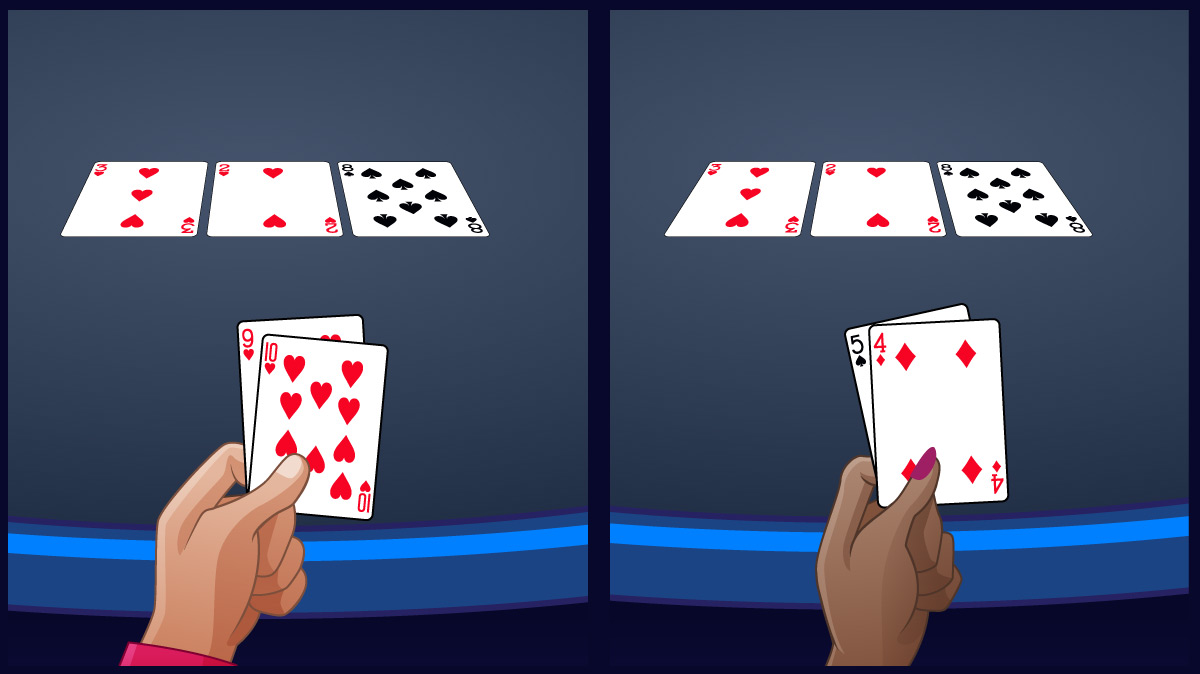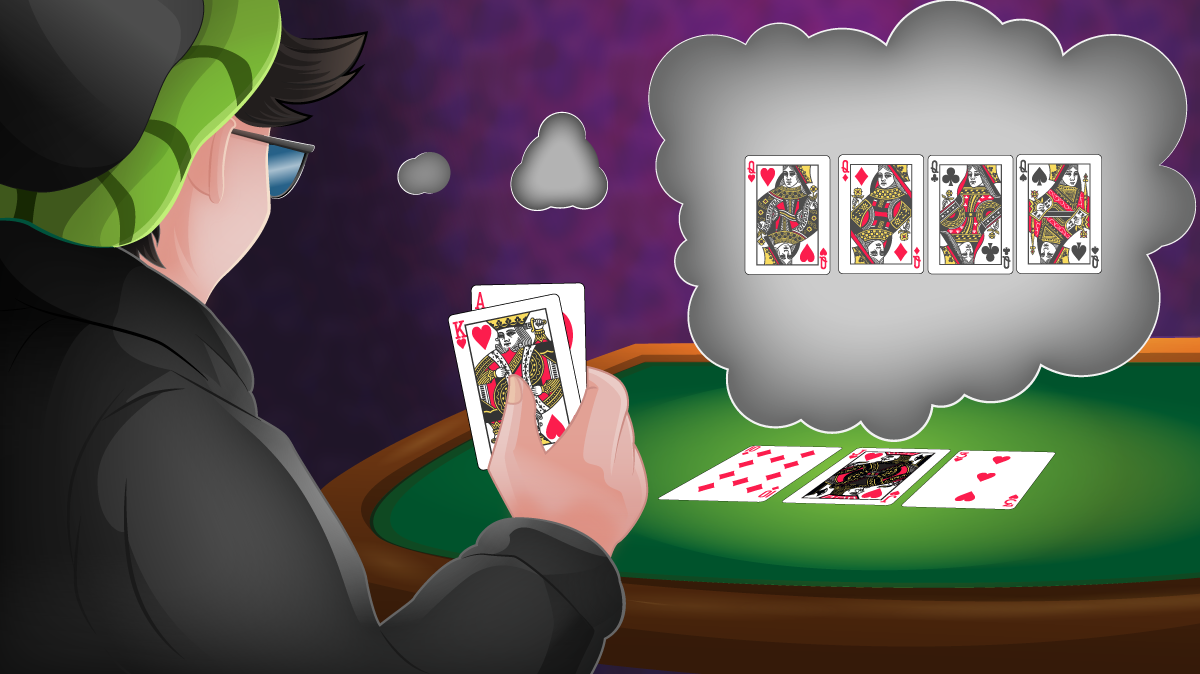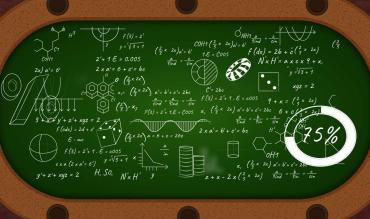To play almost any casino game successfully, some knowledge of math is required. But no casino game requires the knowledge and the application of pf math during play more than the game of poker. The two most significant mathematical indicators for successful poker play are odds and outs. This article will explore both of these in some detail in order to give the reader a decent feel for what they are and why they matter.
Table of Contents
ODDS
Simply put, odds are the chances – for or against – the player making a particular hand. If a player holds four cards of a flush, the odds against completing the flush are calculated at approximately 4-to-1. The numbers can be a little confusing. They don’t mean that the player has a 1-in-4 chance (25 percent) of completing the hand. Instead, they mean that out of five hands, one hand will complete the flush and four will not. So, 4-to-1 odds means the player will complete 1 flush in about 5 hands or about 20 percent of the time. Keep in mind that the mathematical poker odds are calculated over the long run. In the short term, a player could complete a flush when holding four of a suit four, five or more hands in a row – or go 15, 20 or more poker hands without ever completing a flush.

Some players find it easier to use percentages while others prefer to use odds. Let’s look at some examples of converting odds to percentages.
- 2-to-1 against is the same as one out of three times, so 100 / 3 = 33.3 percent.
- 3-to-1 against is the same as one out of four times, so 100 / 4 = 25 percent.
- 4-to-1 against is the same as one out of five times, so 100 / 5 = 20 percent.
- 5-to-1 against is the same as one out of six times, so 100 / 6 = 16.7 percent.
How about going the other way – percentage to odds?
- 33 percent – 100 / 33 = 3, so 3 - 1 = 2 making the odds 2-to-1.
- 25 percent – 100 / 25 = 4, so 4 - 1 = 3 making the odds 3-to-1.
- 20 percent – 100 / 20 = 5, so 5 - 1 = 4 making the odds 4-to-1.
- 7 percent – 100 / 16.7 = 6, so 6 - 1 = 5 making the odds 5-to-1.
An alternative method of converting a percentage into odds is to divide the percentage of not hitting by the percentage of hitting.
- 33 percent: 33 percent chance of hitting, 67 percent chance of not hitting: 67 / 33 = 2, making the odds 2-to-1.
- 25 percent: 25 percent chance of hitting, 75 percent chance of not hitting: 75 / 25 = 3, making the odds 3-to-1.
- 20 percent: 20 percent chance of hitting, 80 percent chance of not hitting: 80 / 20 = 4, making the odds 4-to-1.
- 7 percent: 16.7 percent chance of hitting, 83.3 percent chance of not hitting: 83.3 / 16.7 = 5, making the odds 5-to-1.
It does not matter whether you prefer to use odds or percentages. What is important is that you understand how odds and percentages work so you can apply this knowledge to the game of poker.
OUTS
In order to calculate odds, a poker player needs to know the number of “outs.” An out is just a shortcut way of saying the number of cards remaining in the deck which will help complete a hand. In the example above of a hand with four suited cards, the number of cards (or outs) which will complete a flush hand is nine – each suit has 13 cards, four of those 13 cards are in the hand leaving nine of the same suit remaining.
Some common outs for play after the flop (where you have your two face-down or “hole” cards, and three common cards are showing) are presented in the table below. Since these are quite common, it is a good idea to commit these to memory.
|
Outs |
You Have |
You Hope to Make |
|
2 |
A Pair |
3 of a Kind |
|
4 |
Full House |
|
|
4 |
Inside Straight |
Straight |
|
8 |
Open Straight |
Straight |
|
9 |
Four of a Flush |
Flush |
|
15 |
Straight and Flush |
Straight / Flush plus |
The next table shows specific examples to help clarify how outs are determined.
|
Type of Draw |
Hand |
Flop |
Out Cards |
# Outs |
|
Pair to 3-of-a-Kind (Set) |
3♠ 3♣ |
K♦ 2♥ 8♣ |
3♥ 3♦ |
2 |
|
One Overcard (higher than flop) |
A♥ 6♠ |
9♣ 3♦ 2♣ |
A♠ A♣ A♦ |
3 |
|
Inside Straight |
8♥ 6♣ |
9♠ 5♦ Q♣ |
7♠ 7♣ 7♥ 7♦ |
4 |
|
Two Pair to Full House |
Q♠ J♥ |
Q♥ J♠ 4♣ |
Q♣ Q♦ J♣ J♣ |
4 |
|
One Pair to Two Pair or Set |
K♣ J♦ |
K♦ 9♣ 3♠ |
K♠ K♥ J♠ J♣ J♥ |
5 |
|
No Pair to Pair |
8♦ 6♣ |
2♣ 3♥ J♦ |
8♠ 8♣ 8♥ 6♠ 6♥ 6♦ |
6 |
|
Two Overcards to Over Pair |
A♠ Q♣ |
9♥ 7♦ 3♣ |
A♣ A♥ A♦ Q♠ Q♥ Q♦ |
6 |
|
Set to Full House / 4-of-a-Kind |
5♣ 5♦ |
5♠ 7♥ Q♣ |
5♥ 7♠ 7♣ 7♦ Q♠ Q♥ Q♦ |
7 |
|
Open Straight Draw |
7♦ 6♣ |
5♦ 8♥ 2♠ |
9♠ 9♣ 9♥ 9♦ 4♠ 4♣ 4♥ 4♦ |
8 |
|
Flush Draw |
Q♦ T♦ |
K♦ 5♦ 7♠ |
2♦ thru 4♦, 6♦ thru 9♦, J♦ A♦ |
9 |
|
Inside Straight & Two Overcards |
K♠ Q♥ |
J♦ 9♠ 3♣ |
J-all, K♣ K♥ K♦ Q♠ Q♣ Q♦ |
10 |
|
Inside Straight Draw & Flush |
A♣ K♣ |
J♣ Q♦ 2♣ |
T-all, 3♣ thru 9♣, Q♣ |
12 |
|
Open Straight & Flush Draw |
K♦ Q♦ |
T♦ J♣ 3♦ |
9-all, A-all, 2♦ 4♦ thru 8♦, J♦ |
15 |
As you can see from the above tables, counting outs is not very complicated. Even so, there are some things which must always be remembered.
- Outs cannot be counted twice. In the last row of the table above, there are 15 outs. There are only 15 cards that can complete a flush or straight. If you do a quick count in your head you may come up with 17 outs – 8 outs for a straight and 9 outs for a flush. Because the hand has both a straight and flush possibility, one out can count for both a straight and a flush. In the example, the A♦ and 9♦ serve a double role of completing either a flush or a straight. Be careful with this situation when in live play. You don’t want to assume you have more chances of completing your hand than you really have.
- Some outs won’t help you win. At times there are outs that will improve your hand but won’t help you win the hand. As an example, consider this hand. You hold the 6♥ 5♠ and the flop contains the 7♣ 4♦ J♣. You are drawing to a straight, and any 3 or 8 will make it for you. But, the flop also contains two clubs, so if you hit the 3♣ or 8♣, you will have a straight, but someone else could beat you with a flush. In reality, you only have six good outs out of the usual eight outs. Don’t assume that all outs are good outs and will help you. I always prefer to err on the side of caution and only count the good outs. There is no sense putting your hard-earned money at risk without knowing you have the best odds possible to win.
DETERMINING YOUR POKER ODDS

Once you have calculated your good outs, you are ready to determine your odds. Three ways to do just that are shown below. The first method requires no calculations. It is the table below. It shows the odds of hitting your hand (based on your outs) from flop to turn, turn to river and flop to river.
|
|
Flop to Turn |
Turn to River |
Flop to River |
|||
|
Outs |
Percent |
Odds |
Percent |
Odds |
Percent |
Odds |
|
20 |
42.6 |
1.35-1 |
43.5 |
1.30-1 |
67.5 |
0.48-1 |
|
19 |
40.4 |
1.47-1 |
41.3 |
1.42-1 |
65.0 |
0.54-1 |
|
18 |
38.3 |
1.61-1 |
39.1 |
1.56-1 |
62.4 |
0.60-1 |
|
17 |
36.2 |
1.77-1 |
37.0 |
1.71-1 |
59.8 |
0.67-1 |
|
16 |
34.0 |
1.94-1 |
34.8 |
1.88-1 |
57.0 |
0.75-1 |
|
15 |
31.9 |
2.13-1 |
32.6 |
2.07-1 |
54.1 |
0.85-1 |
|
14 |
29.8 |
2.36-1 |
30.4 |
2.29-1 |
51.2 |
0.95-1 |
|
13 |
27.7 |
2.62-1 |
28.3 |
2.54-1 |
48.1 |
1.08-1 |
|
12 |
25.5 |
2.92-1 |
26.1 |
2.83-1 |
45.0 |
1.22-1 |
|
11 |
23.4 |
3.27-1 |
23.9 |
3.18-1 |
41.7 |
1.40-1 |
|
10 |
21.3 |
3.70-1 |
21.7 |
3.60-1 |
38.4 |
1.60-1 |
|
9 |
19.1 |
4.22-1 |
19.6 |
4.11-1 |
35.0 |
1.86-1 |
|
8 |
17.0 |
4.88-1 |
17.4 |
4.75-1 |
31.5 |
2.17-1 |
|
7 |
14.9 |
5.71-1 |
15.2 |
5.57-1 |
27.8 |
2.60-1 |
|
6 |
12.8 |
6.83-1 |
13.0 |
6.67-1 |
24.1 |
3.15-1 |
|
5 |
10.6 |
8.40-1 |
10.9 |
8.20-1 |
20.3 |
3.93-1 |
|
4 |
8.5 |
10.75-1 |
8.7 |
10.50-1 |
16.5 |
5.06-1 |
|
3 |
6.4 |
14.67-1 |
6.5 |
14.33-1 |
12.5 |
7.00-1 |
|
2 |
4.3 |
22.50-1 |
4.3 |
22.00-1 |
8.4 |
10.90-1 |
|
1 |
2.1 |
46.00-1 |
2.2 |
45.00-1 |
4.3 |
22.26-1 |
Using the above table, it is easy to see that if you are holding a flush draw after the flop (meaning you have nine outs) you have a 19.1 percent chance – or odds of 4.22-to-1 against – of hitting it on the turn. With both the turn and river yet to come, you have a 35 percent chance (or 1.86-to-1 odds against) hitting the flush.
The next method for determining your poker odds is to simply do the math – simple to say, a bit more complicated to perform. In fact, the calculations are so complex that it would be a waste of time and space to put them in this article. It would be a lot of work for me, and you would probably fall asleep trying to follow the process, so let’s move on.
Fortunately, there is a shortcut process. Although it is not entirely accurate, is close enough for playing poker. It is called the Four and Two Method.
- Multiply your outs by four if both the turn and river are yet to come.
- Multiply your outs by two if only the river is yet to come.
Using the same flush draw example, if someone goes all-in and you are guaranteed to see both the turn and the river cards, multiply your outs (nine) by four, and you get 36 percent. This calculation is slightly different from the chart but very close – close enough for play.
If there is just one more card to come, multiply your outs (nine) by two to get 18 percent. Again, it is not exact, but close enough for play.
SUMMARY
That is all. Everything you need to know about poker odds and outs to form the basis of successful poker play. Obviously, several other skills are needed to become a truly successful poker player. They will be covered in future articles. For now, if you can understand and determine the proper out count and remember the simple Four and Two Method of determining the win percentage, you are well on your way to fun and profit while playing poker.
You can contact Jerry “Stickman” at stickmanjerry@aol.com


